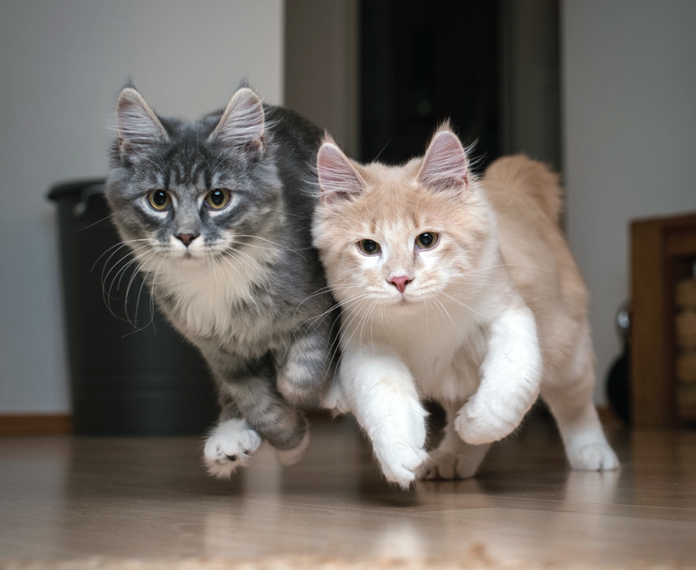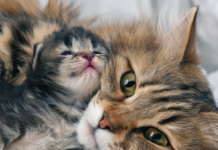You are resting on the sofa after a long day and suddenly your young cat comes blasting through the room like a whirlwind and then is gone. Outbursts of FRAPing (Frenetic Random Activity Periods) are a fact of life for owners of young cats. Think of this as a case of the “zoomies.” Older cats can experience this too, but it is much more common in kittens and teenage cats.
Your other cats may watch in awe or it may be a group activity, with cats from young to old flying through your house. Sometimes one cat will zoom and once she has stopped, another one will pick up the urge to run—or they’ll join up. Your dog may or may not choose to join in as well.
Why the zoomies? Especially at night, when you were sleeping comfortably? FRAPing is generally felt to be a chance for your cat to blow off some excess energy. Cats normally sleep up to 17 hours a day. That doesn’t leave much time for eating and exercising. Some behaviorists believe that FRAPing may provide practice for hunting behaviors.
Cats have a variety of versions of FRAPing. The classic kitten version starts with a sideways dance toward you, with back arched and tail high and kinked (you can picture this!). Hissing and hair standing on end may be part of this ritual as well. Then, suddenly, there is a mad dash off, again usually with tail kinked. Some cats will yowl or hiss while running or meow loudly.
Warning Signs
Dilated eyes are often a sign of a FRAP about to happen. This is a good warning sign (don’t try to pick up or cuddle your cat when her eyes are dilated) that is often accompanied by a twitching tail. She is revving her motor, so to speak, and at that moment she might bite or scratch you. This is a state of extreme arousal.
The stimulus? Possibly a bug. Possibly an imaginary foe. Maybe you twitched your foot or exhaled loudly. Tapping your finger on the floor. It doesn’t take much to get her going when your feline companion is overflowing with energy. FRAPing commonly occurs after a bath or thorough grooming, and for some cats, after using the litterbox.
“I think it is more evolutionary than anything physiological like a melatonin drop,” says Katherine Houpt, DVM PhD DACVB James Law Professor Emeritus, Section of Behavior Medicine at the Cornell University College of Veterinary Medicine. “I think it is a form of play.”
But the sudden sprint is possibly related to hunting techniques, says Dr. Houpt. “You don’t usually see it in farm cats, who have to work for a living,” she says. “Their predatory behavior involves sitting beside a mouse hole for hours, then pouncing.”
Use Caution
While it can be fun to watch your pet cat do cheetah imitations, if your cat insists on these wild runs in the middle of the night, you might be losing sleep. It is also possible for your cat to get hurt. If these wild runs are common, you might want to put heavy throw rugs on slippery floors so your cat doesn’t wipe out. Block off stairs to prevent a fall. You might be able to stop a zoom attack by waving a toy like a feather wand as your cat flies by, but don’t count on it.
If other pets tend to join in, try to distract or intervene. When in this excitable state, there is a risk of pets turning on each other or even nipping you if you get in the way. Let your cat calm down for 10 minutes or so after a zoom before you try to pick her up.
If your senior cat suddenly starts having the zoomies, consider having her checked for hyperthyroidism. This common cause of increased activity level is usually associated with weight loss and a voracious appetite. Senior cats with dementia may also become active at night, but they tend to walk and meow, not run.
For healthy young cats, frequent zooming may be a sign that your cat needs more exercise and attention. Schedule daily play times with a wand toy or work with your cat on fetching. Many cats will go after a ball of crumpled up aluminum foil or paper. Food puzzle toys for her to interact with when you aren’t home are a good idea.
Some cats will learn to walk on a harness and leash, and supervised outdoor walks can be helpful (make sure your cat is up to date on vaccines if you choose this option).
Work on enriching your cat’s environment. Put a bird feeder outside a window where your cat can watch. Add an aquarium (with a cat-proof cover!). Provide a paper bag (not plastic!) that your cat can play in. An empty box can provide plenty of fun time for your cat. Switch out different cat trees and toys periodically so your cat has new stimulation. If you can, set up a catio so your cat gets some outdoor time in a safe place when you aren’t around.
Consider adding a calming pheromone dispenser, especially to run at night if you aren’t getting enough sleep. If you are home during the day, schedule those play times regularly, so hopefully your cat will sleep at night.
Most cats gradually outgrow the zoomies. You may find yourself missing the days of the wild charges through the house (but not the drape-climbing leaps, of course).
Signs of FRAPing
- A sideways dance
- Arched back
- High tail (maybe kinked)
- Dilated eyes
- Hair standing on end




